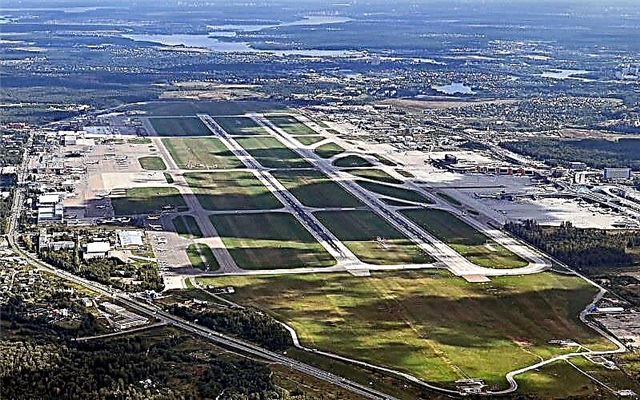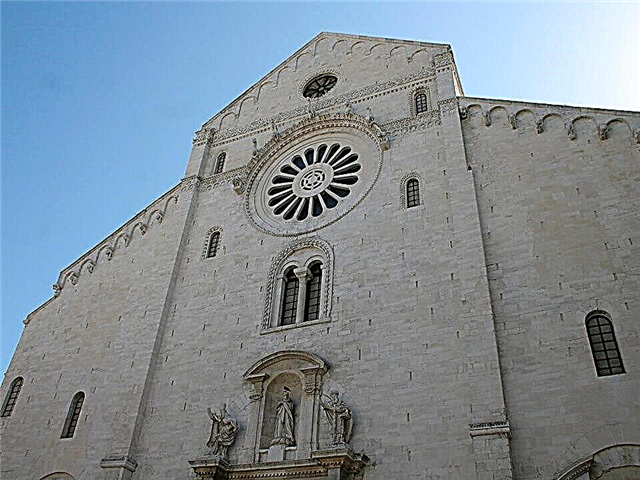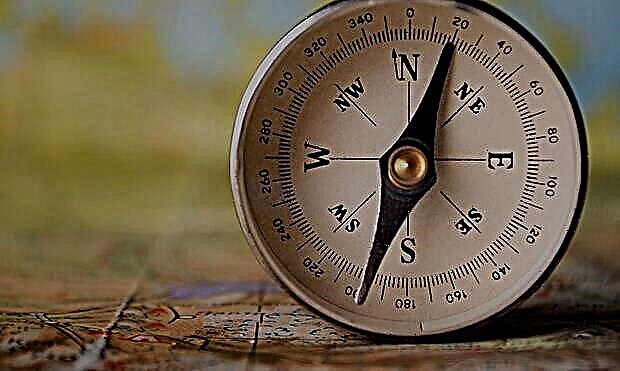Address: Moscow Kremlin, between the Senate and Tsarskaya towers
Build date: 1491 year
Tower height: with a star of 71 m.
A ruby star and chimes are installed on the tower
Coordinates: 55 ° 45'09.2 "N 37 ° 37'17.0" E
Content:
The Spasskaya Tower, which is part of the Moscow Kremlin architectural ensemble, is built into the Eastern Wall. The tower is famous for its chime clock, and it is also the largest among the 20 other Kremlin towers.
The 10-storey Spasskaya Tower was built during the reign of Prince Ivan III by the Italian architect Pietro Solari. Since the temple of Frol and Lavra was located nearby, which has not survived to this day, initially the Spasskaya tower was called Frolovskaya. The exact date of the completion of the construction of the Spasskaya Tower is known in 1491.

View of the tower from the side of the Bolshoi Moskvoretsky bridge
Images above the driveway
In total, 2 images were depicted above the gateway - the Savior of Smolensky adorned the entrance to the Kremlin at the beginning of the 16th century, and already in the second half of the 17th century, the image of the Savior Not Made by Hands appeared from the Kremlin. Tsar Alexei Mikhailovich, by a special decree of 1658, ordered to change the name of the Frolovskiye Gates to Spasskie. The same year can be considered the year when the tower was given a new name - "Spasskaya".
Protective structures of antiquity
After the construction of the Spasskaya Tower (at the time when it was also called Frolovskaya), it was decided to defend the eastern side of the Kremlin with a defensive line. To protect the entrance to the Kremlin, a diverting arrow was installed on the 4-corner Spasskaya Tower, which was quite powerful at that time. Also, additional protection was provided by "gers" - iron bars, covering the tower from 2 sides. As soon as the attackers penetrated the tower, the Gerses descended and isolated them from their army, and from a special gallery at the very top, the enemy was mercilessly destroyed. The strelnitsa gates were additionally equipped with lifting bridges.

View of the Spassky Gate
Spassky Gate is a holy place for every Muscovite
In ancient times, the Spassky Gate was a truly cult place - they were considered holy in the truest sense of the word. The male half of the population was obliged to take off their hats when passing through the Spassky Gate.... If for some reason they refused to take off their clothes or forgot to do so, then it was necessary to redeem their guilt with 50 bows to the ground. Also, the Spassky Gate was a meeting place for Moscow princes and their representatives with foreign ambassadors. And, of course, not a single Kremlin procession could pass the Spassky Gate, even the tsars, before being crowned, also passed through them.
One interesting story is connected with the Spassky Gate and their holy power. It was during the war of 1812. It was at the very moment when the French emperor Napoleon, having seized Moscow, decided to pass the Spassky Gate, the cocked hat from his head was blown away by the wind. His entourage regarded this as a bad sign, and as it has long been known, the sign was justified. Napoleon's criminal decision to blow up this tower is also reliably known. The explosion was prevented thanks to the timely arrival of the Don Cossacks - the "special forces" of that time, which the French were afraid of in panic.

View of the tower from Red Square
Spasskaya Tower in the 17th century
The height of the Spasskaya Tower today is 67.3 meters without the Kremlin star and 71 meters with it. However, the Spasskaya Tower was not always so high - its original height was at least 2 times less. Only in the first half of the 17th century, Russian architects Bazhen Ogurtsov and Christopher Galovey, an English architect, completed the tower with a multi-tiered top, executed in the Gothic style. A stone tent was erected at the very top of the tower. Once upon a time, stone statues were installed at the top and they were even dressed up in specially sewn robes. But, alas, the statues have not survived to our time. In addition to the statues, the facades of the Spasskaya Tower were decorated with white stone reliefs. One of them, a stone relief depicting St. George the Victorious, can be seen in the Tretyakov Gallery.
Around the same time, an arched stone bridge was added to the Spasskaya Tower, thrown over a protective ditch. On this bridge, merchants sold a variety of goods. In the middle of the 17th century, a double-headed eagle was installed on the tent of the Spasskaya Tower, which is the coat of arms of the Russian Federation at the present time. True, at that time the eagle also symbolized autocracy.

View of the tower from the side of the Moskva River and Vasilievsky Spusk
The two-headed eagles were subsequently installed on the other towers of the Moscow Kremlin - Borovitskaya, Troitskaya and Nikolskaya. The reason was their great height, since the eagles should have been clearly visible to most of the Moscow citizens.
On the sides, first of the Frolovsky, and then of the Spassky gates, two chapels were erected - Smolenskaya and Spasskaya. Their second names are interesting: for example, the Spasskaya chapel was christened the Great Council of the Angel, and the Smolenskaya - the Great Council of Revelation. At the very beginning of the 19th century, wooden chapels were demolished and new ones were erected in their place, but already made of stone. And then the war of 1812 broke out. As you know, Napoleon did not particularly stand on ceremony with the cult Russian buildings and ruthlessly destroyed them. Architect Gerasimov P.A. carried out work on the restoration of the Kremlin in 1862 and during their implementation, he restored these 2 chapels: however, according to a completely new project. Newly built and consecrated in October of the same year, the chapels came under the "jurisdiction" of the Intercession Cathedral. The chapels were finally demolished by the Bolsheviks - in 1925 and they were not restored again.

View of the chimes and the ruby star
How the images of the Savior Not Made by Hands and the Savior of Smolensk appeared
In the 16th century, Moscow was liberated from the dictatorship of Khan Makhmet-Girey. In honor of this event, a fresco appeared over the Frolovskaya gate. The image was considered to be of unearthly origin, but whether it was in fact, no one can say for sure. Then the image of the Savior Not Made by Hands was adorned with a gilded robe and placed in an icon case. The image was illuminated with the help of a special non-extinguishing lamp, the responsibility of maintaining the fire in which fell on the priests from St. Basil's Cathedral. And here Napoleon was also unlucky. When his soldiers climbed to steal the salary of the holy image, the stairs collapsed with them, and they simply did not dare to climb for the precious relic a second time. The fresco of the Savior Not Made by Hands was last restored in 1895.
As for the second fresco - the image of the Savior of Smolensk, his fate is shrouded in darkness. Historians know little about him. However, Patriarch Alexy II handed over several icons, made according to old prototypes, to the new President of the Russian Federation, Putin, in 2000. They even wanted to place these icons on the Spasskaya Tower, in the place where the image of the Savior of Smolensk was once painted, but historians doubted their reliability, and with them all the Orthodox clergy. This idea never got materialized.

View of the tower from St. Basil's Cathedral
Relatively recently, in 2007, representatives of the Fund of St. Andrew the First-Called came up with an initiative to restore images over the Spassky Gate. Interestingly, it was about the search for the frescoes of these images, as separate icons - however, time has shown that this was an erroneous version. An ancient image of the image was discovered in 2010, when a white plaster rectangular niche was found above the Spassky Gate. An ancient image of the Savior of Smolensk was discovered under a white layer of plaster.
After a series of consultations with professional historians and restorers, it was decided to start restoring the image of the Savior of Smolensk. It was almost completely disclosed on July 5, 2010. It is believed that at least 80% of the original has survived. The official opening of the gate icon of the Savior of Smolensk took place on August 26, and the consecration - on August 28 of the same 2010... On August 28, during the great church feast of the Dormition of the Theotokos, the image was consecrated. It should be noted that the image of the Savior of Smolensk is the very first gate image in the entire history of the existence of the Spasskaya Tower.
Chimes - the main attraction of Moscow and the Spasskaya Tower
Who has not heard about the chimes installed on the Spasskaya Tower? For most of our contemporaries, chimes are one of the main symbols of two states: one of which is Russia, the second is the USSR. And, of course, most of those who have caught the New Year celebration under the chime of this clock try to hear it again on this wonderful holiday - on the radio or TV.

Chimes on the Spasskaya Tower
It is known that the most important master-creator of this watch is a watchmaker and mechanic from England Christopher Galovey. Its mechanism showed surprisingly accurate time, worked flawlessly, and even played musical melodies. True, his watch displayed the exact time using numbers - there were no hands at that time.
The clock on the Spasskaya Tower acquired a dial only at the beginning of the 18th century - when Peter I ordered to replace Galovey's clockwork with chimes with a 12-hour dial and music. But again, these are not the same Chimes that are installed on the Spasskaya Tower in our time. Their history includes a number of replacements and upgrades. So, in 1851, brothers-watchmakers P. and N. Butentop carried out repairs, and so overhauled that the watch was practically replaced with new ones. Every 6 hours (when the hands showed 6 or 12 o'clock), the newly repaired chimes played the "March of the Preobrazhensky Regiment". When the chimes showed 9 and 3 o'clock, another melody was played - "If our Lord is glorious in Zion" by the Russian composer Dmitry Bortnyansky. For some reason, the Russian Emperor Nicholas I did not want the clock to play the national anthem, although there were such proposals.

General view of the Spasskaya Tower
Chimes in the 20th century
The clock on the Spasskaya Tower is such a significant monument that it is difficult to talk about the history of the tower without talking about the history of the chimes. In 1917, the watch was seriously damaged for the first time: a shell hit it, the mechanism was damaged and the hand was broken. The chimes were inoperative for a year. Lenin was engaged in their repair - on his order, the locksmith Berens and the musician Cheremnykh were connected to the restoration of the Kremlin clock. The chimes started working again, and at 12 o'clock the International played instead of a fight, and at 12 o'clock at night - “You fell a victim in a fatal struggle”. In 1938, by Stalin's decision, the clock began to strike the hours and quarters of an hour, and without any music.
And only in 1996, during the inauguration ceremony of Russian President Boris Yeltsin, the Kremlin clock again began to play musical melodies. At every 3rd and 9th hour the chimes played a fragment of the opera "A Life for the Tsar" by the famous Russian composer Glinka - the melody "Glory". And every 12th and 6th hour - "Patriotic song". The chimes were last restored in 1999. Now "Patriotic Song" has been replaced with the anthem of the Russian Federation.
How are the chimes arranged?
The chimes differ from most tower clocks in that they have 4 dials - one on each of the 4 sides of the Spasskaya Tower. The diameter of each is 6.12 m. A hammer connected to a special mechanism rings a bell every hour. Until 1937, the watch was wound by hand, now it is done with the help of 3 electric motors.

Fresco of the Savior of Smolensky over the Spassky Gate
About the Kremlin star
It's hard to believe, but until 1935 the famous five-pointed star on the Spasskaya Tower had not yet been installed. A two-headed eagle flaunted on top of it. Then, in 1935, the first star appeared - a copper one, covered with gilding and decorated with Ural gems. The first version of the Kremlin star differed from today's size - it was not much larger. Then the star faded, and somehow the discrepancy between its dimensions and the dimensions of the tower became noticeable. In 1937, the star was changed for the second time to a ruby one and was not changed again. The Kremlin star is illuminated around the clock using a powerful 5-kilowatt electric lamp. By the way, the star can rotate like a weather vane and change its position depending on where the wind is blowing. Well, those who are eager to see the previous version of the Kremlin star can easily do it - they just have to go to Moscow's Northern River Station and look at the spire of its building.
After the restoration of the fresco of the Savior of Smolensk in 2010, there were several statements demanding that the star be removed from the Spasskaya Tower and replaced with a two-headed eagle. However, there has been no real progress in this direction yet.











